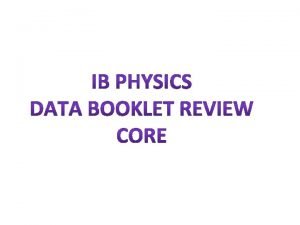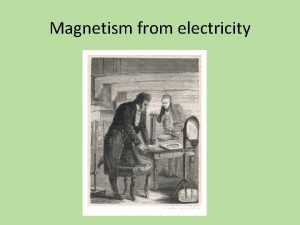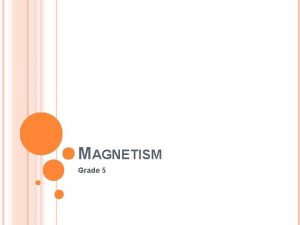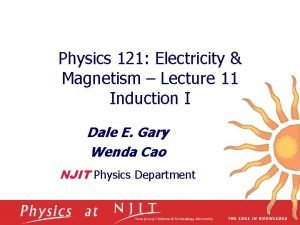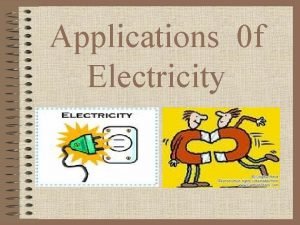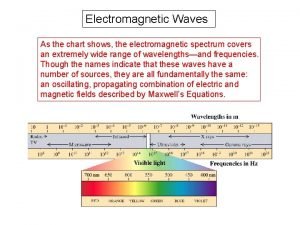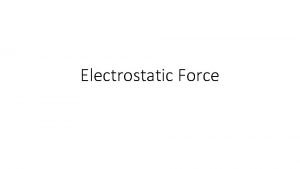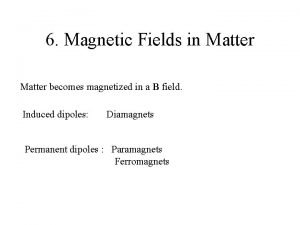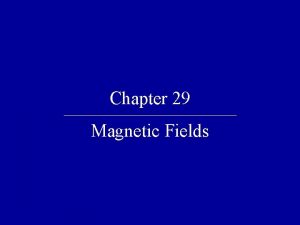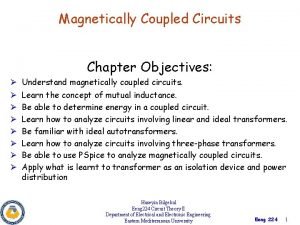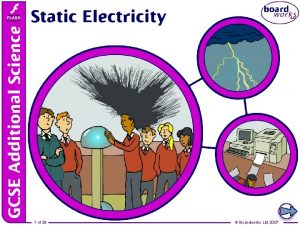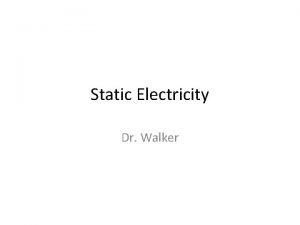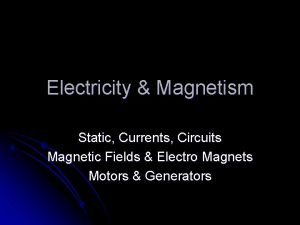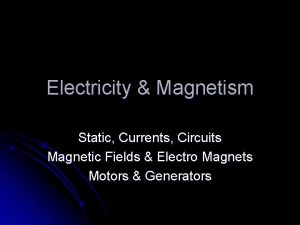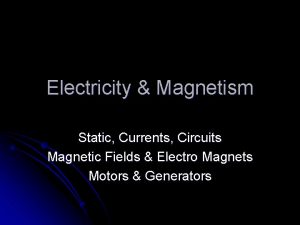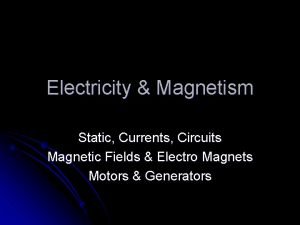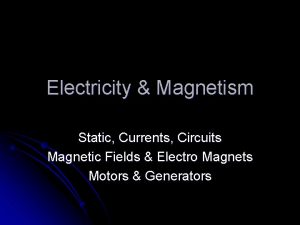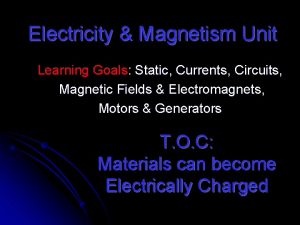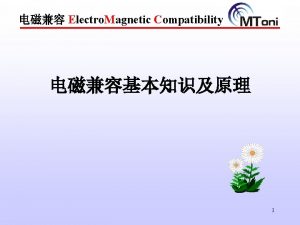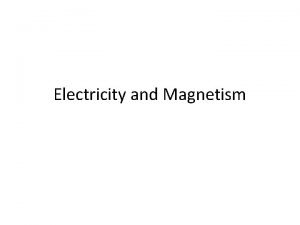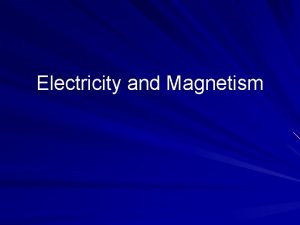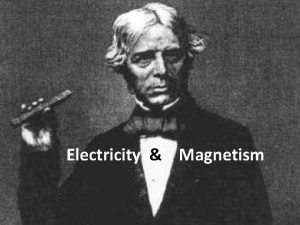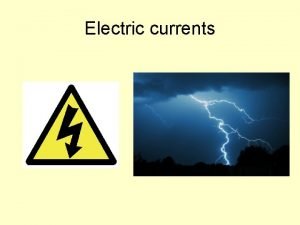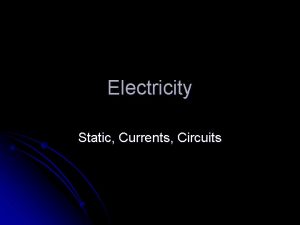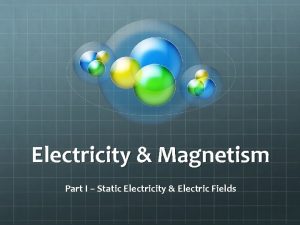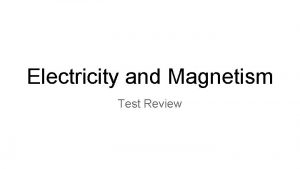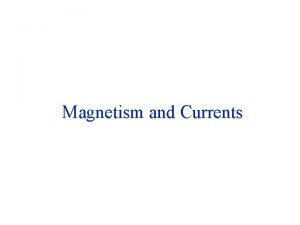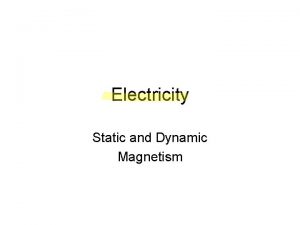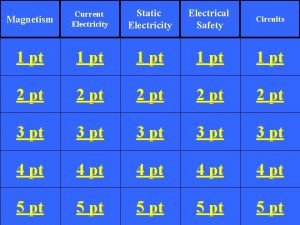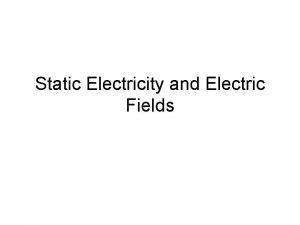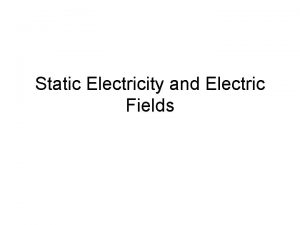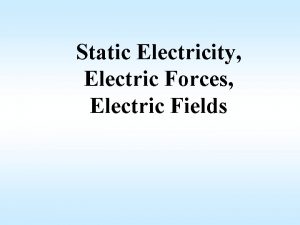Electricity Magnetism Static Currents Circuits Magnetic Fields Electro
































- Slides: 32

Electricity & Magnetism Static, Currents, Circuits Magnetic Fields & Electro Magnets Motors & Generators

Facts about Magnetism Magnets have 2 poles (north and south) l Like poles repel l Unlike poles attract l Magnets create a MAGNETIC FIELD around them l

Magnetic Field A bar magnet has a magnetic field around it. This field is 3 D in nature and often represented by lines LEAVING north and ENTERING south To define a magnetic field you need to understand the MAGNITUDE and DIRECTION We sometimes call the magnetic field a B-Field as the letter “B” is the SYMBOL for a magnetic field with the TESLA (T) as the unit.

Magnetic Force on a moving charge B S N vo - S N If a MOVING CHARGE moves into a magnetic field it will experience a MAGNETIC FORCE. This deflection is 3 D in nature. The conditions for the force are: • Must have a magnetic field present • Charge must be moving • Charge must be positive or negative • Charge must be moving PERPENDICULAR to the field.

Atoms… l Have neutrons, protons, and electrons. l Protons are positively charged l Electrons are negatively charged

Electrons… l Are located on the outer edges of atoms…they can be moved. l A concentration of electrons in an atom creates a net negative charge. l If electrons are stripped away, the atom becomes positively charged.

The world is filled with electrical charges: + - + + + + + -

What is this electrical potential called? l Static - Electricity - - - + ++ ++

Static Electricity l The build up of an electric charge on the surface of an object. l The charge builds up but does not flow. l Static electricity is potential energy. It does not move. It is stored.

Static Discharge… l Occurs when there is a loss of static electricity due to three possible things: l. Friction - rubbing l. Conduction – direct contact l. Induction – through an electrical field (not direct contact)

Electricity that moves… l Current: The flow of electrons from one place to another. l Measured in amperes (amps) l Kinetic energy

How can we control currents? l With circuits. l Circuit: is a path for the flow of electrons. We use wires.

There are 2 types of currents: l Direct Current (DC) – Where electrons flow in the same direction in a wire.

There are 2 types of circuits: l Series Circuit: the components are lined up along one path. If the circuit is broken, all components turn off.

Series Circuit

There are 2 types of currents: l Alternating Current (AC) – electrons flow in different directions in a wire

There are 2 types of circuits: l Parallel Circuit – there are several branching paths to the components. If the circuit is broken at any one branch, only the components on that branch will turn off.

Parallel Circuit



Conductors vs. Insulators l Conductors – material through which electric current flows easily. l Insulators – materials through which electric current cannot move.

Examples l Conductors: l Insulators: l Metal l Styrofoam l Water l Rubber l Plastic l Paper

What is Resistance? l The opposition to the flow of an electric current, producing heat. l The greater the resistance, the less current gets through. l Good conductors have low resistance. l Measured in ohms.

What Influences Resistance? l Material of wire – aluminum and copper have low resistance l Thickness – the thicker the wire the lower the resistance l Length – shorter wire has lower resistance l Temperature – lower temperature has lower resistance

What is Voltage? l The measure of energy given to the charge flowing in a circuit. l The greater the voltage, the greater the force or “pressure” that drives the charge through the circuit.

Difference b/t Volts and Amps l Example l Amps – you could say that… measure how much water comes out of a hose. l Volts measure how hard the water comes out of a hose.

Ohm’s Law l Resistance l Ohms = Voltage / Current = Volts / Amps

What is an electromagnet? l Electromagnet – a magnet made from a current bearing coil of wire wrapped around an iron or steel core.

l http: //www. youtube. com/watch? v=i. Su. SWi 7 YTh. A

What is a generator? l Generator – a machine that changes mechanical energy to electrical energy l Usually use moving magnets to create currents in coils of wire.

l http: //www. youtube. com/watch? v=Nqd. Oyx. JZj 0 U #aid=P 89 ox 56462 A

That’s It !!!!
 Electric currents and magnetic fields
Electric currents and magnetic fields Visualizing magnetic field
Visualizing magnetic field Current electricity
Current electricity Magnetism vocabulary
Magnetism vocabulary Static electricity and current electricity
Static electricity and current electricity What is a deep current
What is a deep current Red fields
Red fields Magnetism and electricity
Magnetism and electricity Electricity and magnetism
Electricity and magnetism Magnetism jeopardy
Magnetism jeopardy Electricity and magnetism
Electricity and magnetism Electricity and magnetism grade 5
Electricity and magnetism grade 5 4 forces of nature
4 forces of nature Electricity and magnetism
Electricity and magnetism Sph3u electricity and magnetism
Sph3u electricity and magnetism Electricity and magnetism
Electricity and magnetism Topic 5 ib physics
Topic 5 ib physics Electromagnet experiment hypothesis
Electromagnet experiment hypothesis Ampere
Ampere Electricity and magnetism lecture notes
Electricity and magnetism lecture notes Electromagnetic waves chart
Electromagnetic waves chart Em spectru
Em spectru Chapter 24 magnetism magnetic fundamentals answers
Chapter 24 magnetism magnetic fundamentals answers Electric force meaning
Electric force meaning Magnetism lesson outline answer key
Magnetism lesson outline answer key Magnetic field in matter
Magnetic field in matter Magnetic force quiz
Magnetic force quiz Learning: module 26: magnetic forces and fields
Learning: module 26: magnetic forces and fields Advantages of parallel circuits over series circuits
Advantages of parallel circuits over series circuits Magnetically coupled circuit
Magnetically coupled circuit Basic electrical engineering kulshreshtha
Basic electrical engineering kulshreshtha 2007
2007 Triboelectric series
Triboelectric series








